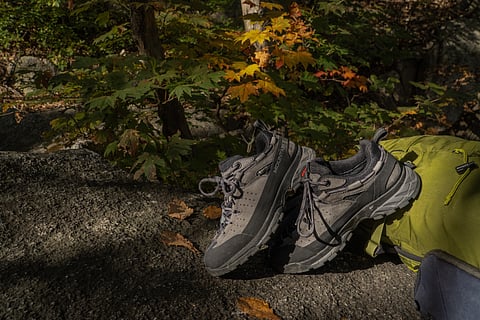
- Destinations
- Experiences
- Stay
- What's new
- Editor’s Picks
- Responsible Tourism
- CampaignsCampaigns
- Subscribe

Trekking shoes are the unsung heroes of any outdoor adventure. Whether exploring rugged mountain terrains, traversing forest trails, or hiking through rocky paths, having the right footwear can significantly impact your overall experience. Finding the ideal trekking shoes is crucial for comfort, safety, and endurance during long hikes. To aid you in this quest, here's your guide to finding the perfect trekking shoes for your adventures.
An essential feature often overlooked is the shoe's traction. A solid grip is paramount for stability and safety, especially on slippery or steep terrains. Look for shoes with deep and multidirectional lugs on the outsole, providing excellent traction. These lugs are akin to the treads on a tire, ensuring a firm grip on various surfaces. Prioritise this feature to prevent slips and maintain stability throughout your trekking adventures. Without adequate grip, even the most comfortable and durable shoes might fall short of providing the necessary support for your outdoor explorations.
Getting the right shoe size is fundamental for a comfortable trekking experience. Ill-fitting shoes can lead to blisters, discomfort, and potential injuries. Remember, your feet might swell during long hikes, so opt for a slightly roomier fit. Ensure enough space at the front for your toes to wiggle without being too loose. Try on various sizes and styles, considering the width and shape of the shoe as well. A proper fit ensures your feet are adequately supported, reducing the risk of discomfort and allowing you to fully enjoy your outdoor excursions.
Softness and flexibility in trekking shoes play a significant role in your overall comfort and manoeuvrability. While durability is crucial, shoes must be pliable enough to allow natural foot movement. Look for materials that are soft yet resilient, providing a balance between protection and agility. Flexibility allows your feet to adapt to varying terrains, reducing fatigue and enhancing your hiking experience. Testing the shoes' flexibility by bending and twisting them can give you a good indication of how they'll perform during your treks. Opt for shoes that offer a good blend of sturdiness and suppleness for an ideal trekking experience.
Ankle support is a crucial factor, particularly in challenging terrains. Shoes with adequate ankle support help prevent twists, strains, and potential injuries. For longer treks or uneven surfaces, consider shoes with higher ankle coverage or supportive elements like padded collars and sturdy lacing systems. These features provide stability, especially when carrying heavier loads. While hiking shoes may offer more flexibility, hiking boots generally provide better ankle support, which is crucial for rougher terrains. Prioritise ankle support based on the type of trek and your comfort needs to ensure a safer and more enjoyable hiking experience.
Ensuring your trekking shoes are water-resistant is essential, especially if you expect damp conditions or unpredictable weather. Shoes with water-resistant materials or waterproof membranes help keep your feet dry and comfortable. However, it's important to note that while some shoes are waterproof, they might compromise breathability. Consider the balance between keeping moisture out and allowing sweat to escape. Understanding the terrain and weather conditions of your trek will guide your choice. For wetter environments or stream crossings, prioritise waterproof or water-resistant shoes to maintain dryness and prevent discomfort during outdoor adventures.
